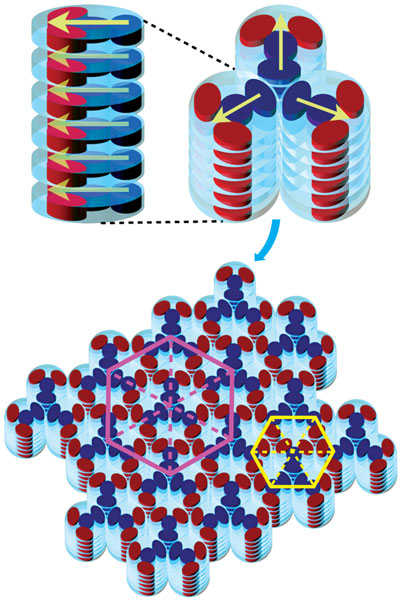| May 02, 2013 |
A liquid crystal force to reckon with
|
|
(Nanowerk News) A need for fast, solution-based processing of organic electronic devices has sparked increased interest in ‘discotic’ or disc-shaped liquid crystals. These molecules, which contain a flat aromatic core surrounded by hydrocarbon side chains, can spontaneously pile into column-like structures that could be ideal for one-way charge transport. Research led by Takashi Kajitani and Takanori Fukushima from the RIKEN Advanced Science Institute has now revealed a way to turn individual discotic columns into liquid crystal films with unprecedented hierarchical order in two dimensions ("Amphiphilic Design of a Discotic Liquid-Crystalline Molecule for Dipole Manipulation: Hierarchical Columnar Assemblies with a 2D Superlattice Structure").
|
 |
| Disrupting the natural packing tendencies of disc-shaped liquid crystals (light blue cylinders) produces stacked columns with significant dipole moments (top left). These columns self-assemble into hierarchical triangular (top right) and hexagonal films (bottom) perfectly aligned for organic electronic applications.
|
|
Chemists recently discovered that the formation of columns from discotic molecules is enhanced when the molecules contain bond dipoles—electrochemical imbalances that exist between atoms such as carbon and nitrogen. These dipoles increase the polarization of the ‘pi’-bonds that stack aromatic rings together, leading to better column alignment and better electronic pathways. However, discotic columns self-assembled in this manner have no net dipole; instead, the discs pack with alternate ‘head-to-tail’ layering to minimize free energy, which cancels out the columns’ electronic activity.
|
|
Kajitani, Fukushima and their colleagues tried a different approach in order to produce ‘head-to-head’ stacked discotic columns with significant dipole moments. Starting with dibenzophenazine, an aromatic ring containing carbon–nitrogen bond dipoles, they attached two types of side chains: one consisting of hydrophobic paraffin chains and another of hydrophilic triethylene glycol. The team anticipated that microscopic phase separation between the different side-chain regions could force the discs into a single orientation during aqueous self-assembly.
|
|
Synchrotron x-ray experiments revealed that the modified discotic molecules generated diffraction patterns unlike any seen before—a ‘superlattice’ of columns packed into triangle shapes that press together into a two-dimensional hexagonal film with extended lateral order. According to the researchers, this is clear evidence that head-to-head discotic stacking was successful. The striking film patterns are a consequence of the self-assembly neutralizing the large column dipoles over an extended space. “Liquid crystals normally occupy a space between states of matter, so finding a stable structure with wide-ranging two-dimensional lattice correlation is remarkable,” says Kajitani.
|
|
Intriguingly, they also found that the superlattice columns stacked almost perfectly perpendicular to a glass surface, whereas most other discotic techniques generate a mix of horizontal and vertical orientations. Conductivity measurements showed that this spontaneous ‘homeotropic’ alignment yields directional charge transport properties suitable for high-efficiency organic electronics. Kajitani notes that the unique assemblies created using this technique may be suitable for applications such as organic thin film solar cells and fuel cell assemblies.
|

